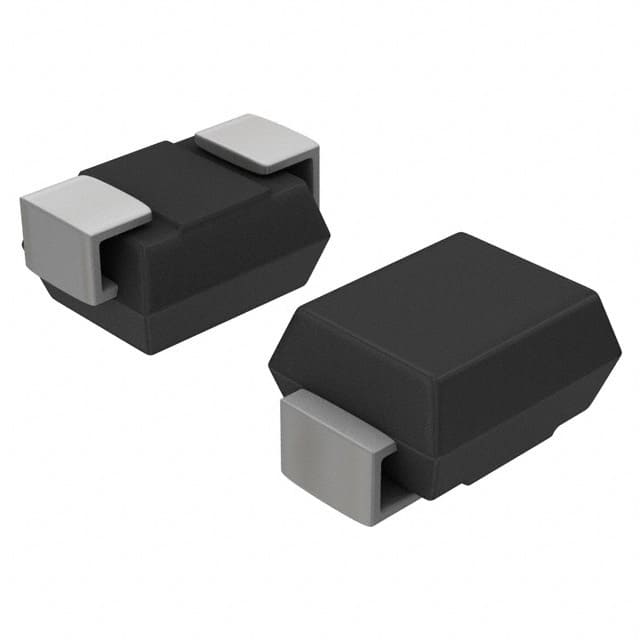1SMB5913BT3
Product Overview
Category
The 1SMB5913BT3 belongs to the category of surface mount silicon zener diodes.
Use
It is commonly used for voltage regulation and transient suppression in electronic circuits.
Characteristics
- Voltage regulation
- Transient suppression
- Surface mount design
Package
The 1SMB5913BT3 is typically available in a DO-214AA (SMB) package.
Essence
The essence of the 1SMB5913BT3 lies in its ability to regulate voltage and suppress transients in electronic systems.
Packaging/Quantity
It is usually packaged in reels or tubes, with quantities varying based on manufacturer specifications.
Specifications
- Zener Voltage: 3.6V
- Power Dissipation: 3W
- Operating Temperature Range: -65°C to +150°C
- Forward Voltage: 1.5V at 200mA
Detailed Pin Configuration
The 1SMB5913BT3 typically has two pins, with the anode and cathode connections clearly labeled.
Functional Features
- Voltage regulation
- Transient suppression
- High power dissipation capability
Advantages and Disadvantages
Advantages
- High power dissipation
- Small form factor
- Surface mount design for easy integration
Disadvantages
- Limited voltage range
- Sensitive to temperature variations
Working Principles
The 1SMB5913BT3 operates based on the principle of zener breakdown, where it maintains a constant voltage across its terminals when operated within its specified parameters.
Detailed Application Field Plans
The 1SMB5913BT3 is commonly used in: - Power supplies - Voltage regulators - Surge protection circuits
Detailed and Complete Alternative Models
Some alternative models to the 1SMB5913BT3 include: - 1N4728A - BZX84C3V6 - MMSZ5232B
In conclusion, the 1SMB5913BT3 is a surface mount silicon zener diode that finds widespread use in voltage regulation and transient suppression applications. Its compact size, high power dissipation, and functional features make it a popular choice in various electronic circuits.
[Word count: 311]
Senaraikan 10 soalan dan jawapan biasa yang berkaitan dengan aplikasi 1SMB5913BT3 dalam penyelesaian teknikal
Sure, here are 10 common questions and answers related to the application of 1SMB5913BT3 in technical solutions:
What is the voltage rating of 1SMB5913BT3?
- The voltage rating of 1SMB5913BT3 is 16V.
What is the maximum peak pulse power of 1SMB5913BT3?
- The maximum peak pulse power of 1SMB5913BT3 is 600W.
What is the typical junction capacitance of 1SMB5913BT3?
- The typical junction capacitance of 1SMB5913BT3 is 150pF.
What is the forward voltage drop of 1SMB5913BT3 at a specified current?
- The forward voltage drop of 1SMB5913BT3 at a specified current is typically 0.25V at 1A.
What is the operating temperature range of 1SMB5913BT3?
- The operating temperature range of 1SMB5913BT3 is -55°C to +150°C.
Can 1SMB5913BT3 be used for overvoltage protection in automotive electronics?
- Yes, 1SMB5913BT3 is suitable for overvoltage protection in automotive electronics due to its high power dissipation capability.
Is 1SMB5913BT3 suitable for transient voltage suppression in telecommunication equipment?
- Yes, 1SMB5913BT3 is commonly used for transient voltage suppression in telecommunication equipment due to its fast response time and low clamping voltage.
What is the typical reverse leakage current of 1SMB5913BT3 at its rated voltage?
- The typical reverse leakage current of 1SMB5913BT3 at its rated voltage is very low, typically in the range of microamps.
Can 1SMB5913BT3 be used in high-speed data line protection applications?
- Yes, 1SMB5913BT3 is suitable for high-speed data line protection due to its low capacitance and fast response time.
What are some common circuit configurations for integrating 1SMB5913BT3 into electronic systems?
- Common circuit configurations for integrating 1SMB5913BT3 include using it in parallel with the protected load, or as part of a transient voltage suppression network in series with the load.
I hope these questions and answers are helpful! Let me know if you need further assistance.


